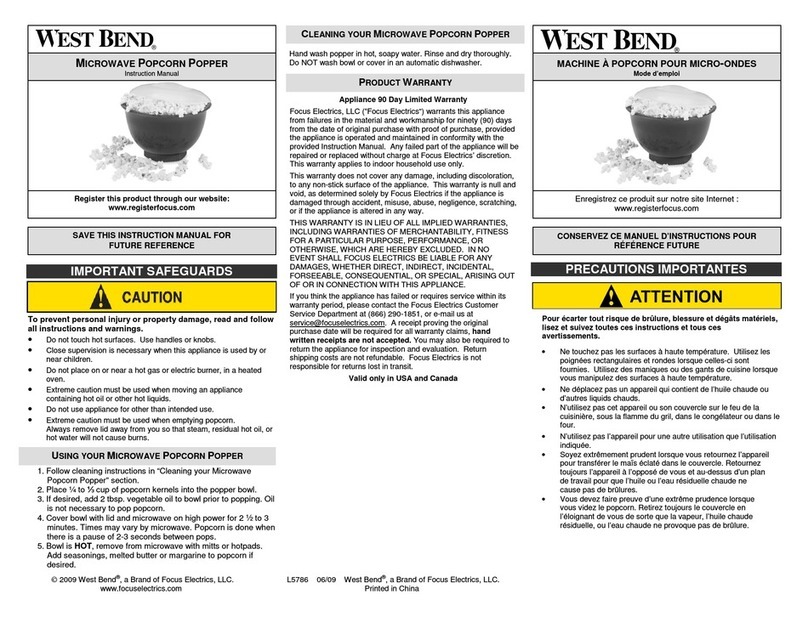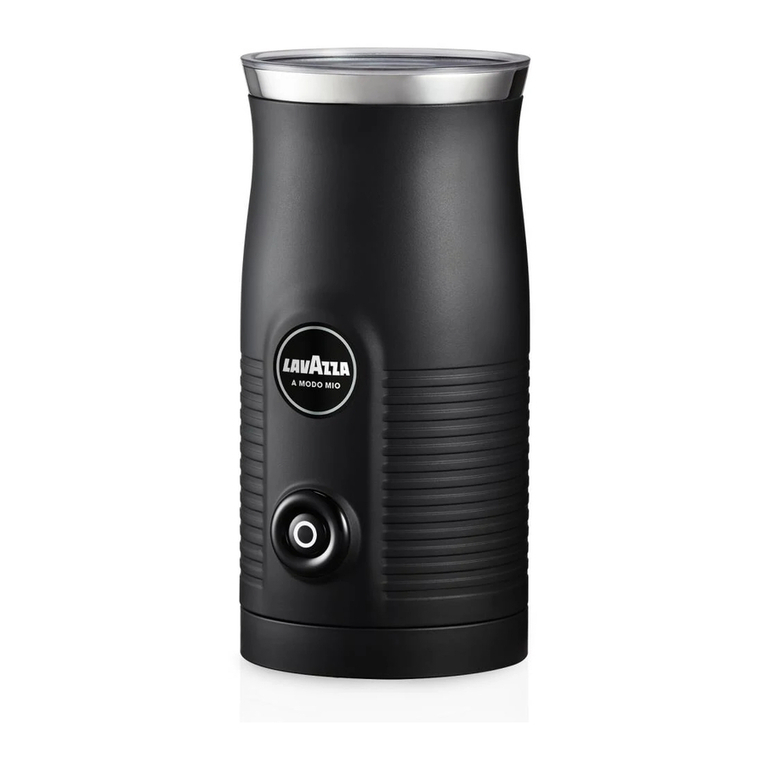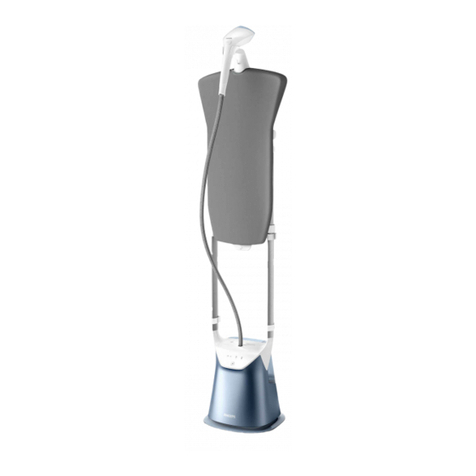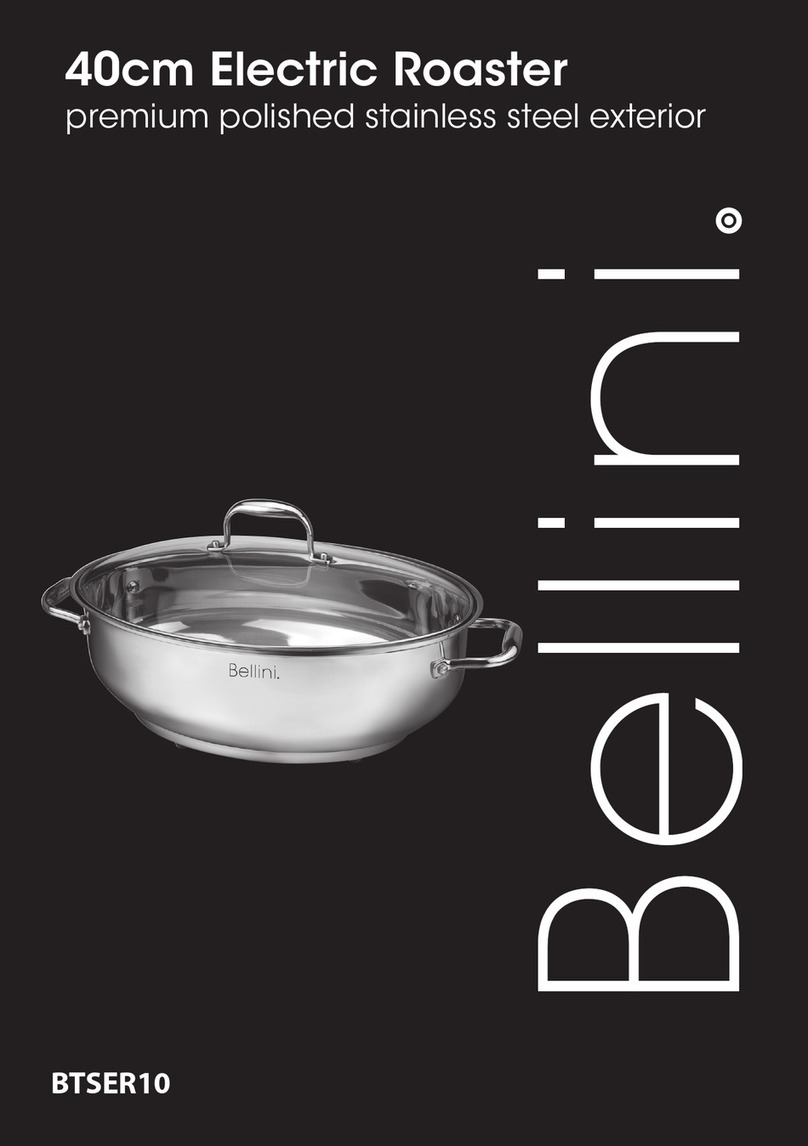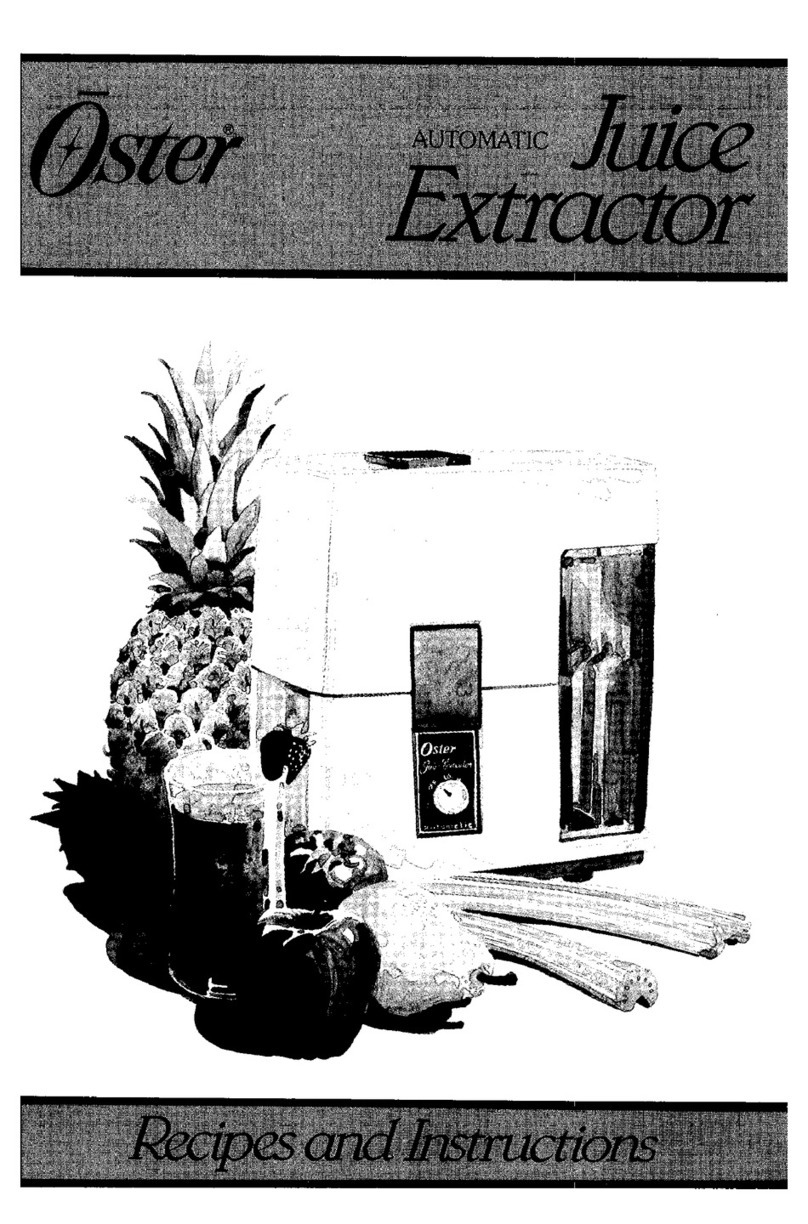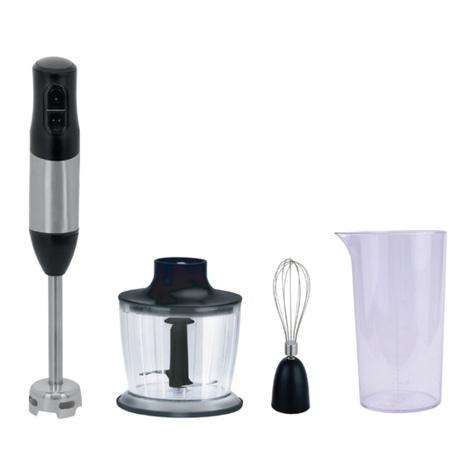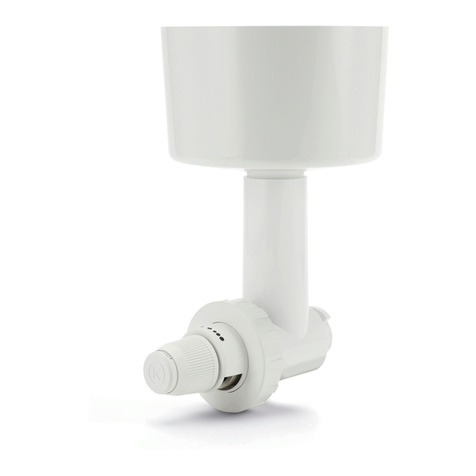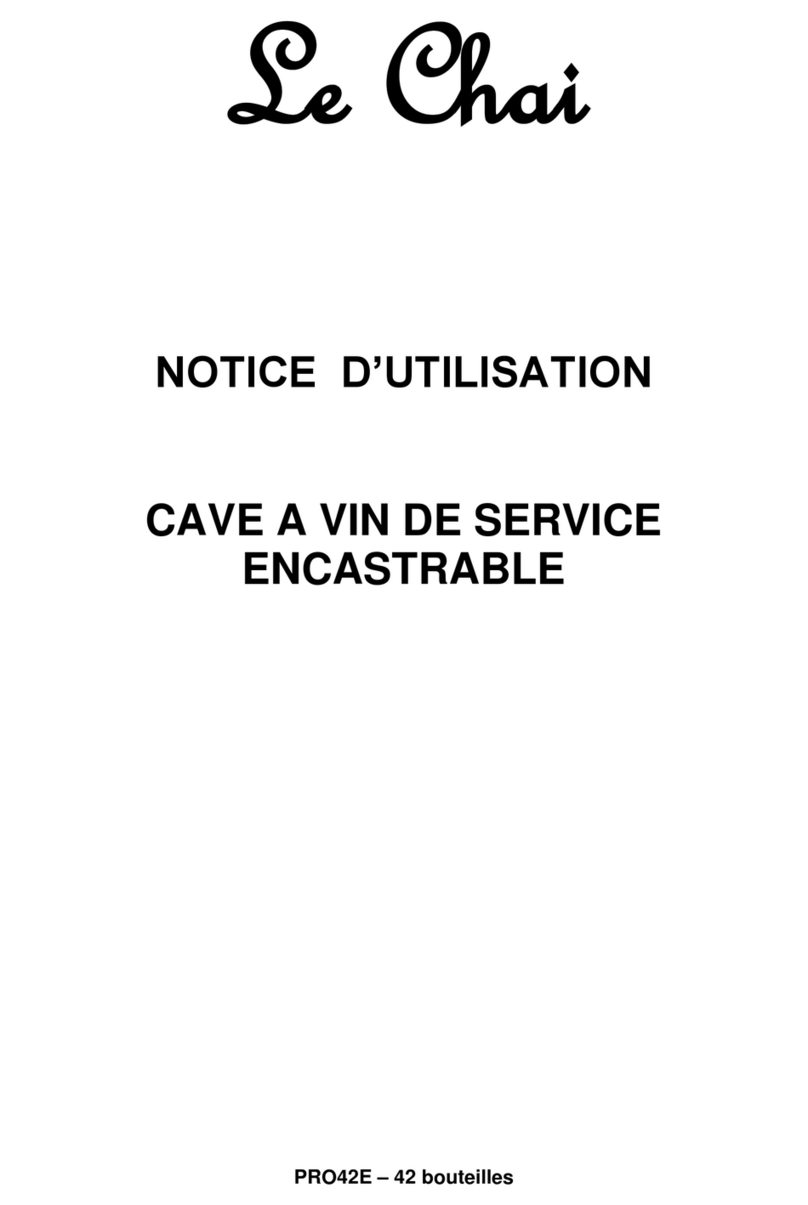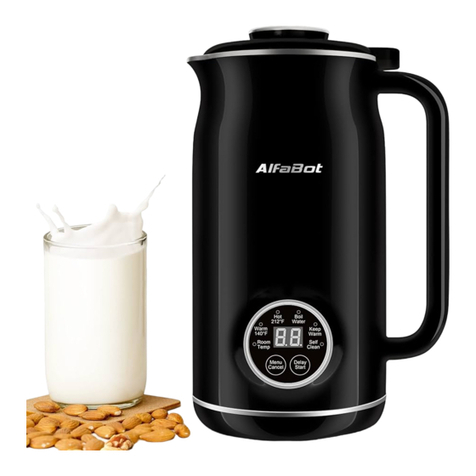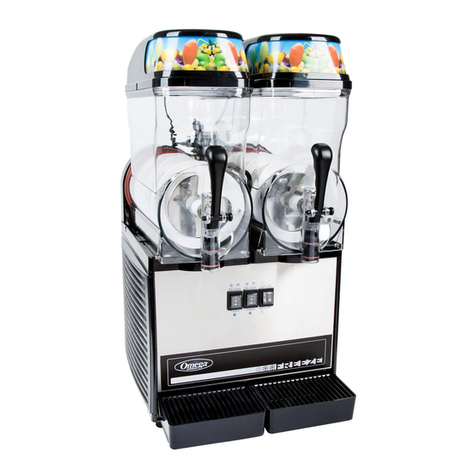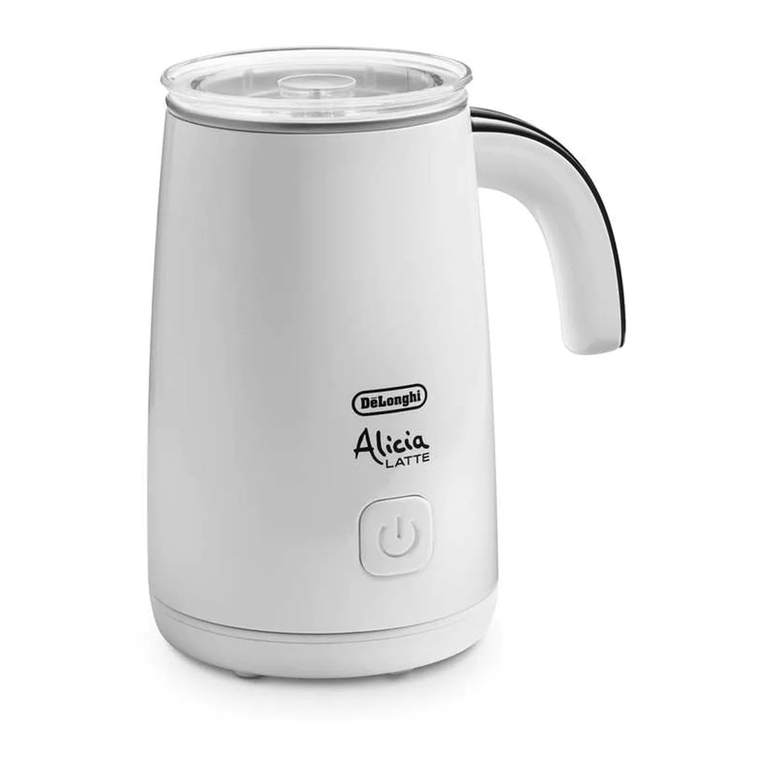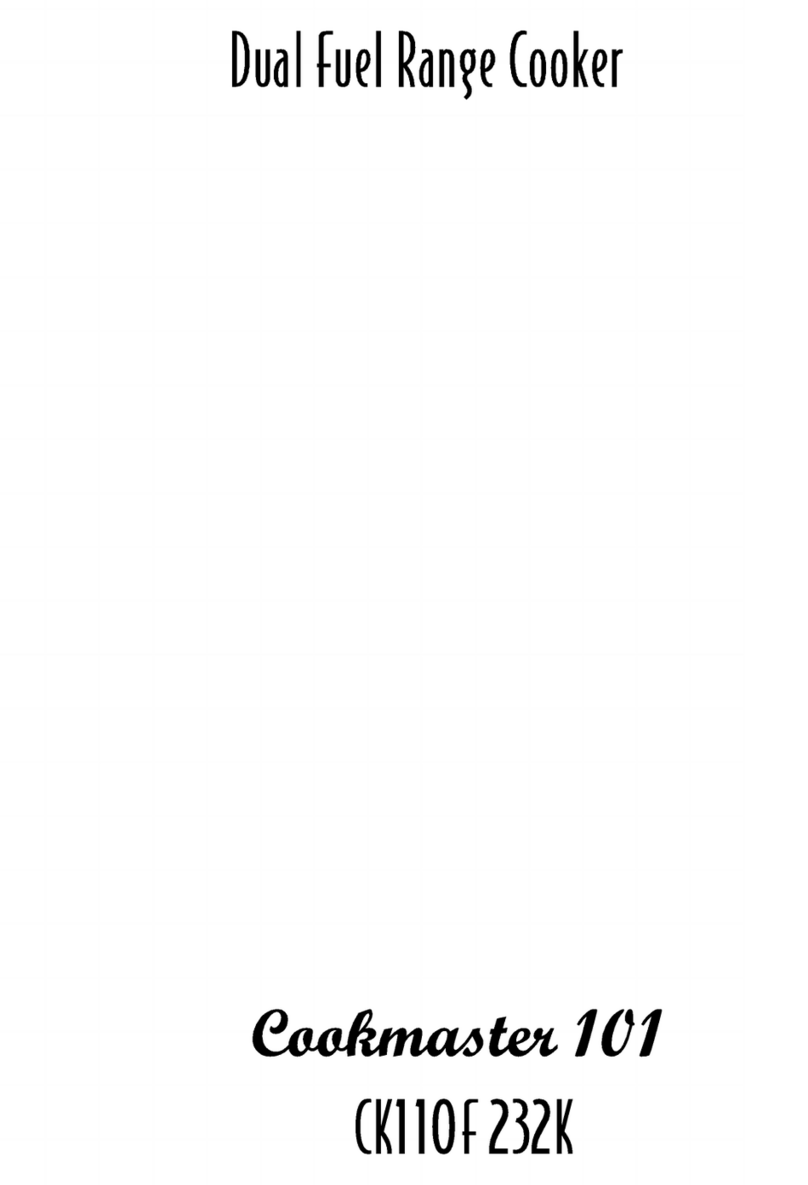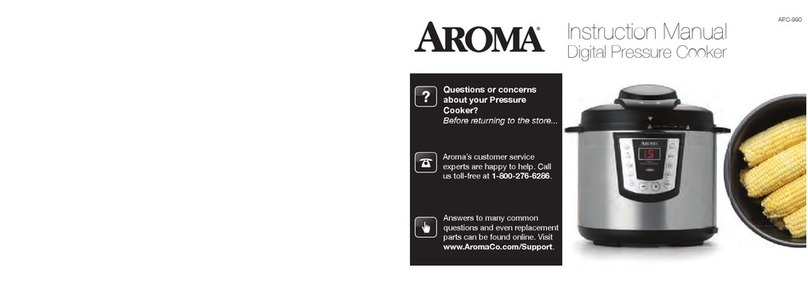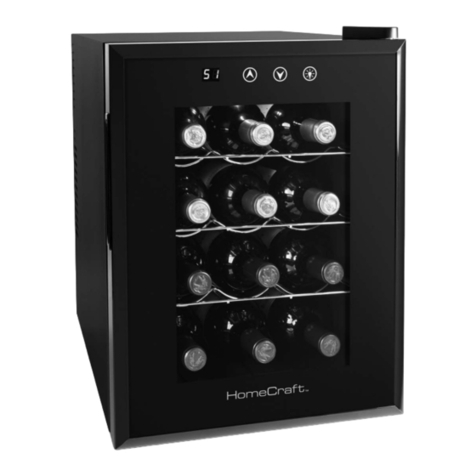Sirman PALLADIO EVO 330 Operating instructions

1
PALLADIO EVO
330
Professional slicer USA
Operating and Maintenance Manual
Code: Edition: 02/2015

2
INTRODUCTION
This manual has been re-presented to provide the Client with all the information on the
machine and its safety regulations, and also the use and maintenance instructions which permit
using the machine in the best way and maintaining its efficiency throughout time.
This manual must be kept in its entirety until the machine is disposed of.
•This manual should be given to personnel in charge of the use and periodic
maintenance of the machine.
INDEX OF CHAPTERS
CHAP. 1 - RECEIVING THE MACHINE page 4
1.1 - PACKAGE
1.2 -CHECKING THE PACKAGE UPON DELIVERY
CHAP. 2 - INSTALLATION page 6
2.1 UNPACKING
2.2 - POSITIONING
2.3 -ELECTRICAL CONNECTION
2.3.1 -Slicer with single-phase motor
2.4 - 115V. ELECTRICAL DIAGRAM - ‘SIDNEY’ PUSH-BUTTON PANEL
2.4.1 -115 V. tension selection
2.5 - PRELIMINARY CHECK
CHAP. 3 - INFORMATION ON THE MACHINE page 9
3.1 - GENERAL PRECAUTIONS
CHAP. 4 - CONSTRUCTION FEATURES page 11
4.2 - SAFETY DEVICES INSTALLED ON THE MACHINE
4.2.1 - Mechanical safety
4.2.2 - Electrical safety
4.3 - DESCRIPTION OF THE MACHINE
4.4 -OVERALL DIMENSIONS, WEIGHT, FEATURES….
CHAP. 5 - MACHINE USE page 16
5.1 - OPERATIONAL CHECK
5.2 -LOADING AND CUTTING THE PRODUCT
5.2 - SHARPENING THE BLADE
CHAP. 6 - ROUTINE CLEANING page 19
6.1 -GENERALITIES
6.2 - CLEANING THE MACHINE

3
CHAP. 7 - MAINTENANCE page 22
7.1 GENERALITIES
7.2 BELT
7.3 FEET
7.4 FEEDING CABLE
7.5 BLADE
7.6 GRINDERS
7.7 SLIDE GUIDES LUBRICATION
7.8 PUSH-BUTTON PANEL LABEL
CHAP. 8 - DISMANTLING page 23
8.1 PUTTING OUT OF SERVICE
8.2 DISPOSAL

4
CHAP. 1 - RECEIVING THE MACHINE
1.1 - PACKAGE
The slicer is shipped in a package which consists of (Fig. n°1): cardboard box, wooden pallets and
protective nylon. They should be disposed of separately and according to the norms in force in the
country of installation.
Dimensions
AxBxC Gross weight
(Kg)
PL 330 840x870x800 52
Do not place more than one of the same
package on top (Fig. n°3).
WARNING! B
A
C
Fig. n°1
Fig. n°2
Fig. n°3

5
When the package is received, if there is no
external damage proceed to opening it, ma-king
sure that all material is inside. If the package
upon delivery shows signs of tam-pering (Fig. n°
8), impact or fall, it is necessary to present
the damage to the carrier, and within 3 days of
the delivery da-te, indicated on the documents,
make a precise report of the damage. Do not
over-
1.2 - CHECKING THE PACKAGE UPON DELIVERY
Heavy package. Do not lift manually unless with
help of at least three people (Fig. n°5).
Move the package only by electrical trolleys
or manually, equipped with lifting straps (Fig.
n°6).
Do not expose the package to humidity or rain
(Fig. n°4).
Since the center of gravity is not in the middle
of the package, moving it su-spended by
chords orsimilar systems is not advisable (Fig.
n°7).
Fig. n°4
Fig. n°6
Fig. n°5
Fig. n°8
Fig. n°7

6
turn the package!! When transporting it make sure that it is firmly held bythe four corners
(keeping it parallel to the floor).
WARNING!
All operations must be carried out by specialized
personnel (Fig. n°9).
2.1 - UNPACKING
Remove the straps from the package (Fig. n°10)
and lift the cardboard (h). The package should be:
a) the machine on the pallet (Fig. n°11 detail a);
b) ) blade ext ctor (Fig. n°11 detail b);
c) ) 4 feet Fig. n°11 detail c);
d) kit case(Fig. n°11 detail d).
e) ) Instruct n booklet (detail e) .
CHAP. 2 - INSTALLATION
Fig. n°9
Fig. n°10
h
a d
Fig. n°11
e
b c

7
2.2 - POSITIONING
Position the pallet, with the slicer, on a flat
surface and take off (a) the sharpe-ner from the
slicer (Fig. n°12).
At this point turn the machine on its side (Fig.
n°13) and unscrew, with the proper wrench
provided, the 4 nuts which fasten the slicer.
Remove the 4 washers and unscrew the 4
fastening tie rods on the wooden pallet. Take off
the pallet and fasten the 4 feet provi-ded.
Finally, put the sharpener in its place.
Position the slicer in the predestined place.
The dimensions indicated in Tab. 1-2-3
(according to the model) must be kept in mind
for the plane where the slicer will be installed,
therefore it must be wide enough, well-levelled,
dry, smo-oth, robust, stable about 80 cm high off
the ground and at least 20 cm from walls,
objects, shelves, etc. (Fig. n°14) in respect to
the space necessary for its use and
safeguarding. Furthermore the machine must be
pla-ced in an environment with a maximum
humidity of 75%, not salty and with a
temperature between +5°C and +35°C; in any
case in environments which do not lead to
deviations of the above.
Make sure the graduated handgrip is inposiion
“0”.
Check the alignment of the blade-plane thickness
gauge by running a finger (Fig. n°16) from the
blade towards the thickness gauge plane (never
in the op-posite direction). Unscrew and screw
the foot (1) until the correct alignment is found
(Fig. n°17), then screw the rub-ber part (2) to fix
everything (Fig. n°17).
a
~ 80cm
20cm
Fig. n°12 Fig. n°13
Fig. n°14
Fig. n°15
Fig. n°16 Fig. n°17
20cm
20cm
1
2
20cm

8
2.3 - ELECTRICAL CONNECTION
Check that the data reported on the
technical-part number plate (Fig. n°18), the
delivery documents and the order, correspond;
contact the supplier for cla-rification if they do
not.
At this point make sure that the system is
standard and that the cable and grounding
system perfectly operate.
2.3.1 - Slicer with single-phase motor Fig. n°18
2.4 - 115 V. ELECTRICAL DIAGRAM , ‘SIDNEY’ PUSH-BUTTON
Fig. n°20
The slicer is equipped with a feeding cable with a cross section area of AWG; length ≅1.5m
and a “UL” plug. Connect the 120 V. - 60 Hz slicer, interposing a magnetothermic differential
switch of 10A,Ι∆ = 0.03A.
2.4 - 120 V. ELECTRICAL DIAGRAM SWITCH
Fig. n°19
—–
—–

9
2.5 - PRELIMINARY CHECK
Before testing make sure the goods holder
plate is well-blocked, after which test functioning
with the following procedure:
-Push the “ON” and the “OFF”
(ARREST) (Fig. n°21);
-Check if the machine does not start
automatically by removing the plug and
reinserting it while the machine is running.
CHAP. 3 - INFORMATION ON THE MACHINE
3.1 - GENERAL PRECAUTIONS
The general precautions, even though they appear obvious, are fundamental for the installation,
use, maintenance and possible inconveniences with their respective solutions.
Fig. n°21
“ON”
“OFF”
•The slicer has been designed to cut fresh
boneless meats and pork pro-ducts (Fig. n°
22). Any other use, including cutting
vegetables, is conside-red unappropriate and
therefore dangerous.
•The Manufacturer is not responsible in the
following cases:
⇒the machine is tampered with by
unauthorized personnel;
⇒components are substituted with
unoriginal parts;
⇒the instructions in this manual are
not followed carefully;
⇒the surfaces of the machine are treated
with inappropriate products.
Keep this manual in a safe place for future
information or consultation (Fig. n°23).
WARNING!
Fig. n°22
Fig. n°23

10
•The slicer must only be used by trained
personnel who know the safety norms
contained in this manual perfectly.
•In the case of an alteration in personnel, give
time for training.
•Do not allow the slicer to be usedby children
or by untrained people
(Fig. n°24).
•Before carrying out any cleaning or-
maintenance operation, disconnect the
machine plug from the electrical network.
•When carrying out routine mainte-nance or
cleaning of the slicer (and therefore the guards
are removed), carefully evaluate the residual
risks .
•During maintenance or cleaning stay
concentrated on the operations.
•Do not use corrosive or flammable substances
to clean the slicer (Fig. n°25); only use the
product provided
•
•
To clean the slicer carefully follow the
instructions in the chapter: “Routine cleaning”.
Do not wash the slicer in a dishwa-sher (Fig. n
°26) or with water jets, do not immerge it in
water or in other liquids.
ATTENTION!
•Do not leave the slicer exposed to damaging
agents: sun, rain, sprays, humidity, ice (Fig. n
°27).
Fig. n°25
Fig. n°26
Fig. n°27
Fig. n°24

11
•Do not pull the slicer or the feeding cable (Fig.
n°28) to unplug it.
•Regularly check the state of the fee-ding
cable; a worn out cable or in any case not
intact represents a serious electrical danger.
•If the machine remains unused for long
periods of time, before using it again have it
checked by a “Service Center”.
•If the slicer should show signs of
malfunctioning it is advisable to turn it
off and to not use it, to not directly in-
tervene for repairs, and to contact the
“Service Center”, shown on the back of this
manual.
•Do not leave the slicer uselessly plugged in. Unplug the machine when it is not being used.
•Even if safety devices are installed on dangerous points of the machine, avoid placing hands
near the blade and other moving parts.
•Never cut the product, by now finished, without the aid of the goods pressing arm.
•Do not assume positions thatbring body parts in direct contact with the blade.
CHAP. 4 - GETTING TO KNOW THE SLICER
4.1 - CONSTRUCTION FEATURES
The slicer is made of an anodized alluminum alloy (Peraluman AlMg5). It guarantees contact with
food-stuffs (hygienic) and is resistant to acids and salts apart being highly resistant to oxidation.
The blade is in 100 Cr6 rectified, chromium-plated and hardened steel assuring a precise and net cut
of the product even after being sharpened. The majority of the other components present are in:
-ABS:
-AISI 430 or 304 steel.
Fig. n°28

12
LEGEND:
1 Sharpener handgrip 12 Base
2 Sharpener 13 Extractable pin
3 Thickness gauge plane 14 Blade cover
4 Handguard 15 Goods presser
5 Push-button panel 16 Goods presser handgrip
6 Foot 17 Blade cover tie rod knob
7 Graduated handgrip 18 Sliceguard
8 Stem 19 Thickness gauge plane sharpener handgrip
9 Stem knob 20 Thickness gauge plane sharpener
10 Lifting lever (optional) 21 Knob movement carriage tray
11 Goods holder plate
5
7
8 9
10
11
12
13
6
4
3
2
1
15 14
Fig. n°29
20
19
18
17
16
21

13
4.2 - SAFETY DEVICES INSTALLED ON THE MACHINE
4.2.1 - Mechanical safety
As far as mechanical safety is concerned, the slicer described in this manual responds to:
-UL 763 machine directives;
-the CSA 22.2 norm.
4.2.2 - Electrical safety
As far as electrical safety is concerned, the slicer described in this manual responds to:
-the UL 763 norms;
-the CSA 22.2 norms.
The slicer is therefore provided with:
-As far as hygienic safety is concerned The slicer
described in this manual re-sponds to NSF
Standard 51.
-A relay in the control circuit, that re-quires the
machine to start up again in case of an
accidental loss of electri-city (Fig. n°31).
Safety is made possible by the:
-Thickness gauge plane
-(Fig. n°30 ref. n°1);
-Ring
(Fig. n°30 ref. n°2);
-sharpener
(Fig. n°30 ref. n°3);
-Goods presser
(Fig. n°30 ref. n°4);
- Goods presser handgrip
(Fig. n°30 ref. n°5);
- handguard
(Fig. n°30 ref. n°6);
- Trolley transported only when thickness
gauge plane is at “0”, at the end of the run
and towards operator side.
Relay in
circuit Fig. n°31
6
4
1
3
2
5
Fig. n°30

14
Even though the professional slicers are equipped with the standard mea-sures for electrical and
mechanical protection (both while operating and during clea-ning and maintenance), RESIDUAL
RISKS which cannot be completely elimina-ted in any case exist, highlighted in this manual under
the form of WARNING. They concern the danger of cutting, bruising and other caused by the blade
or by other machine parts.
4.3 - DESCRIPTION OF THE MACHINE
Professional slicers have been designed and made by our company with the pre-cise purpose of
cutting food products (like lunch meat and meats) and they gua-rantee:
-
-maximum safety in use, cleaning and maintenance;
maximum hygiene, thanks to a meticulous selection of materials that come in contact with the
food products, and with the elimination of the edges in the parts of the slicer that come into
contact with the product, in a way that it can be easily and totally cleaned not to mention easily
disassembled;
-maximum cutting precision thanks to the cam mechanism;
-all components are robust and stable;
-maximum silence thanks to the belt transmissions;
-very easy to handle.
4.4 - OVERALL DIMENSIONS, WEIGHT, FEATURES ...
WARNING:
The electrical features of the machine are shown on a plate on the back of the machine.

15
TAB. n°1 - DIMENSION MEASUREMENTS AND TECHNICAL FEATURES
Fig. n°32
Model U.U
.mod. 330
Diameter blade mm 330
Motor Watt/Hp 270/0,37
Cut thickness mm 23
Run of carriage mm 310
Hopper mm 350x290
A x Bmm 465x340
C x D x E mm 660x640x620
F x D mm 730x640
X Y H W mm 265 170 260 225
Net weight Kg 40
Power source Mn
Tf 230V / 50 Hz
230-400V / 50 Hz
Noise level dB 60≤

16
CHAP. 5 - MACHINE USE
5.1 - OPERATIONAL CHECK
For the 1° use follow these
instructions:
-check that installation has been car-ried out
correctly as in chapter 2;
-check that the plate is well fastened with
the lock handgrip (Fig. n°33 ref.1);
-bring the carriage tray in the bottom (a) and
check the correct functioning of the lifting
lever if present (Fig. n°33 ref.2).
-check the sliding of the plate and that it is
free of obstacles on the work counter for
all of its run (Fig. n°34 ref.b);
-check that the goods pressing arm easily
rises and lowers so that it is not impeded in
all its movement (Fig. n°
Fig. n°33
Fig. n°34
- check the opening of the thickness
gauge plane by making the numbered
handgrip turn clockwise and counter-
clockwise (Fig. n°35 ref.d);
d Fig. n°35
- check that the sharpener is well
fastened to the machine and that it is easy
to extract and free of obstacles (Fig. n°36
ref.e).
Fig. n°36
e
1
b
2
c
a

17
Adhere to the following procedure:
1. Lift the goods presser, load the go-ods on the
plate, bringing it close to the thickness gauge,
block it with the proper toothed arm;
2. regulate the desired thickness of the cut with
the graduated handgrip;
3. assume a correct position to avoid accident:
place the right hand on the goods presser
handgrip and, then the left hand next to the
slice guard to take the cut product (without
tou-ching the blade); the body must be
perpendicular to the work plane (Fig. n°37).
WARNING: Do not assume positions
which bring body parts in direct contact
with the blade (ex. Fig. n°38);
4.
5.
6.
then push the “ON” push-button; push the
carriage (plate + goods presser arm +
stem) gently towards the blade, without
applying excessi-ve pressure on the product
with the goods presser arm. The goods will
easily enter the blade, and the slice guided
by the proper sliceguard will detach and fall
on the plane (Fig. n°39);
avoid running the slicer when empty ;
7. at the end of the cutting operation, stop the
machine by putting the switch in the
“OFF” (ARREST) position and put the
graduated han-dgrip at “0”;
8. Carry out resharpening the blade as soon as
the cut product has a threa-ded or rough
surface, therefore the cutting effort increases
(chapter 5.3).
5.2 - LOADING AND CUTTING THE PRODUCT
WARNING: The goods to be cut are loaded on the plate only with the graduated handgrip at “0” and
the motor stopped, being careful with the blade and the points.
Fig. n°37
Fig. n°38
Fig. n°39

18
1.
2.
disinsert the plug from the outlet and carefully
clean the blade with denatured alcohol
so it is degreased; lift (a) the sharpener (1)
and turn it 180° (b Fig. n°40);
5.3 - SHARPENING THE BLADE
WARNING: Before starting to sharpen the blade, pay attention to RESI-DUAL RISKS
(chapter 4.2.2) concerning the dangers of cutting without ha-ving followed the instructions
listed below.
To sharpen the blade, which needs to be done periodically as soon a decrease in cutting is
noticed, the following directions must be adhered to:
Fig. n°40
Fig. n°41
c
d
1
b
a
3. let it go in a way that the sharpener
(c) c) fits on the loc r pins (d Fig. n°41);
4. check also that the blade stays be-tween the
two grinders;
5. insert the pin and start the machine, by
pressing the “ON” push-button;
6. press the push-button (2 Fig.n°42), let the
blade rotate in contact with the grinder for about
30/40 sec. so that a slight burr forms on the
blade edge;
7. press the 2 push-buttons (2 and 3)
contemporaneously for 3/4 sec. and release
them in thesame instant (Fig. n°43);
8. after having completed the sharpe-ning it is
advisable to clean the grin-ders and the blade
(chapter 6.2.3);
Fig. n°42
2

19
N.B.: Do not carry on the deburring operation for more than 3/4 sec. to avoid the
damaging bending of the blade edge.
CHAP. 6 - ROUTINE CLEANING
6.1 - GENERALITIES
•
•
Cleaning the machine must be carried out at least once a day or, if necessary, more frequently .
All the parts of the slicer that come in direct or indirect contact with the food to be cut must be
scrupulously cleaned.
•The slicer must not be cleaned with water cleaning machines or water jets, but with the product
provided and/or with neutral detergents (pH 7), the sanitizer concentration shall comply with
Section 4-501.114, Manual and Mechanical Warewashing Equipment, Chemical Sanitization –
Temperature, pH, Concen-tration, and Hardness of the FDA Food Code. The use of any other
detergent is prohibited. Utensils, brushes and whatever else could damage the machine surface
must not be used.
•If a chemical sanitizer other than chlorine, iodine or quaternary ammonium is used, it shall be
applied in accordante with the EPA-registered label use in-struction.
•This machine shall be cleaned and saitized at intervals to comply with National/state or local
health code.
Fig. n°43
3
2
9.once the operation is finished,
replace the sharpening device in its original
position, doing the procedure in reverse.
Before carrying out any cleaning operation it
is necessary to:
1.disconnect the plug from the electrical
network to completely isolate the machine
from the rest of the system;
2.Bring the graduated handgrip which
regulates the thickness gauge to “0”. WARNING:
Be careful of residual risks from sharp and/or
pointed parts.
6.2 - CLEANING THE MACHINE
6.2.1 - Cleaning the goods holder plate The
trolley (plate +arm +stem) is easily tilting
(Fig. n° 45):
- bring the graduated handgrip to “0” (1
Fig. n°44);
Fig. n°45
1 a
3
2
Fig. n°44
b

20
pH Fig. n°46
6.2.2 - Cleaning the blade, the blade cover and
the ring
WARNING: a pair of metallic gloves must be
worn while cleaning the bla-de (1) (Fig. n°
47).and a damp clothmust be used.
Unscrew the hand grips from the blade cover (1),
(2) and extract the blade cover (3) using the
proper grip to hold it (Fig. n°47). At this point it is
possible to clean the blade (Fig. n°48).
To clean the surfaces opposite the blade and
the ring, the blade must be extracted in the
following way:
1.unhook the blade cover (Fig. n°47);
2.
3.
take out the sharpening device (Fig. n°49
ref.a) and open, by using the graduated
handgrip, the thickness gauge enough to
make the jig (Fig. n°48 ref.b) stick to the blade;
unscrew the three or four screws i (Fig. n°
49 ref.f), depending on the model, which
fasten the blade;
4.rest the jig (b) on the blade, so that the split in
the jig fits in the ring (Fig. n°49 ref.c);
5.match the axes of the two holes (Fig.n°49 ref.d)
on the blade with the two-knobs(Fig. n°49 ref.e)
on the jig, simply making the blade turn to the
desired position;
Fig. n°47
Fig. n°48
Fig. n°49
a
d
f
b
e
c
3
2
1
-bring the trolley (2) to the end of its run (a)
from the controls side; partially unscrew the
plate lock handgrip (3), pull the trolley towards
the operator; completely unscrew the plate
lock handgrip and tilting the trolley (b - Fig. n°
45);
-having taken off the trolley, the goods holder
plate can be carefully cleaned with warm
water, the equipped detergent or neutral
detergent (pH 7) Fig. n°46.
This manual suits for next models
1
Table of contents
Other Sirman Kitchen Appliance manuals
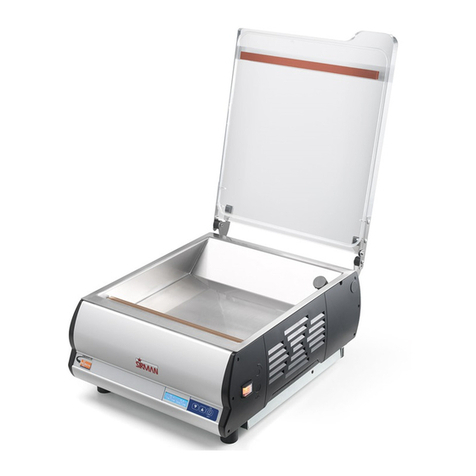
Sirman
Sirman Easyvac 25 User manual
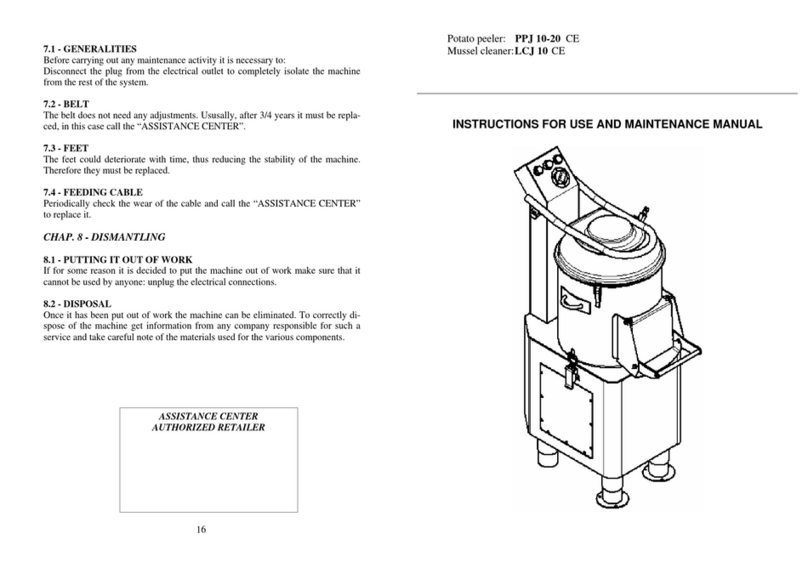
Sirman
Sirman PPJ20 Specification sheet
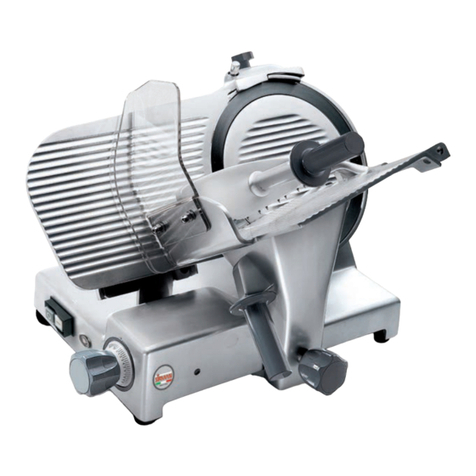
Sirman
Sirman PLL 300 User manual
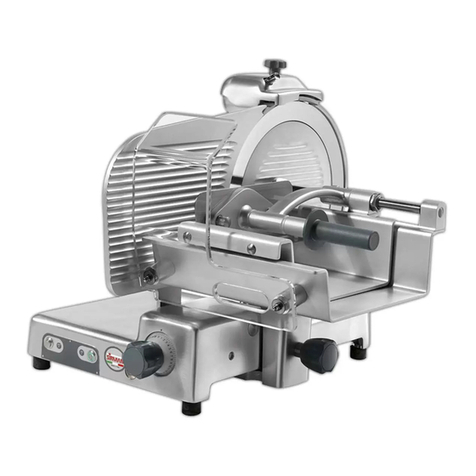
Sirman
Sirman MNT 300 Operating instructions
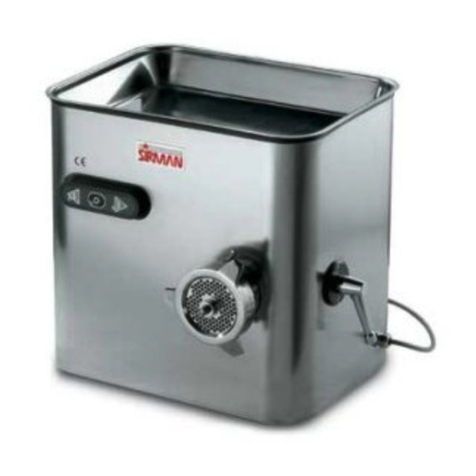
Sirman
Sirman TC RIO 22 User manual

Sirman
Sirman Mirra Series Operating instructions
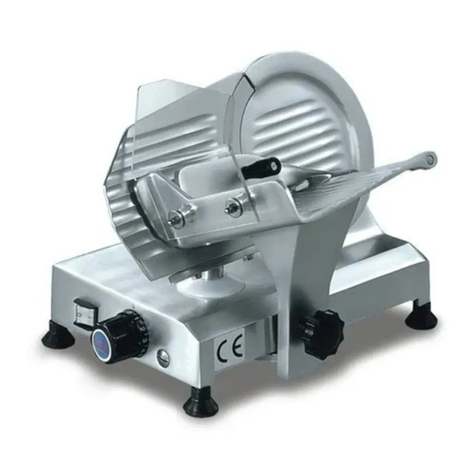
Sirman
Sirman Topaz 195 Operating instructions
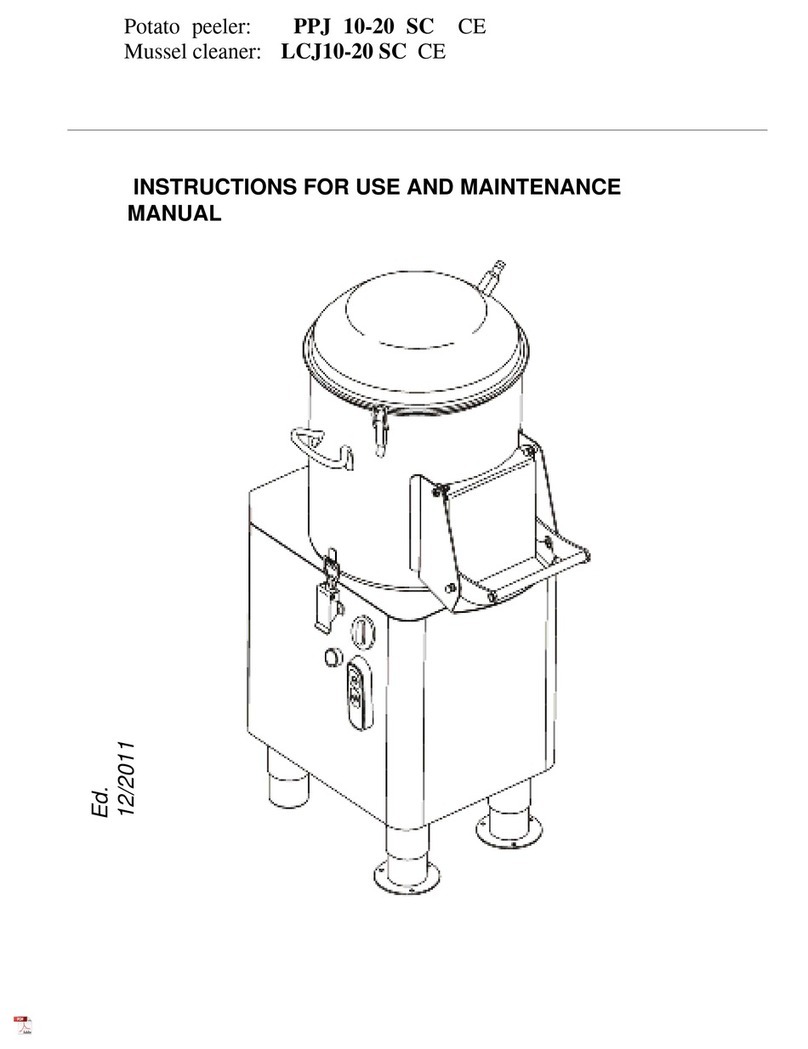
Sirman
Sirman PPJ 10 SC Specification sheet
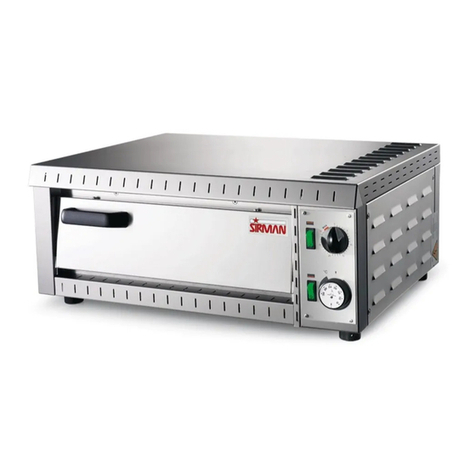
Sirman
Sirman Stromboli Assembly instructions

